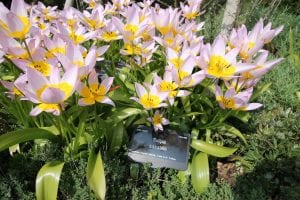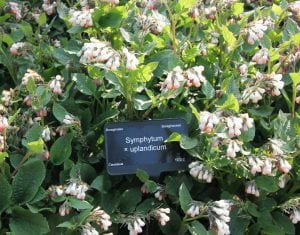By Nicola ‘Froggie’ Rathbone
 If you visit the garden regularly you may have noticed that the green vinyl we normally scribble plant names on with a big black indelible marker pen are being replaced with black and white vinyl. They look pretty much like engraved labels but are far cheaper and easier to replace when a name changes. This has happened quite a number of times since the 1990’s when botanists began looking at the DNA of plants and decided that some have been misnamed…..
If you visit the garden regularly you may have noticed that the green vinyl we normally scribble plant names on with a big black indelible marker pen are being replaced with black and white vinyl. They look pretty much like engraved labels but are far cheaper and easier to replace when a name changes. This has happened quite a number of times since the 1990’s when botanists began looking at the DNA of plants and decided that some have been misnamed…..
Talking of names, I need to explain the layout of the new labels.
|
This may help:-
Accession Number – number given to the plant when it becomes part of the plant collection here. Look this number up in our accession books or on our plant database and you will find information on where it came from in the world or who donated it to the garden. The first 4 digits represent the year (where known, otherwise it will be 0000) when it became part of the collections. E.g. 1980-693. This is the 693rd plant to be accessed ever at this garden and it became part of the collections in 1980.
Country of origin -Self explanatory. Garden origin refers to a seedling appearing in someone’s garden different to its parent plant and then is has been grown on and propagated for distribution to other gardeners. Or it may be a ‘sport‘ where leaves or flowers suddenly appear on the parent plant that are quite different e.g they are variegated. This plant material is then taken as cuttings and grown on for distribution to other gardeners.
Family name – All plants are grouped together into families. Like us humans, it depends on their DNA and how the plants are closely related. Our family is made up of grandparents, parents, children, sisters, brothers, aunts, uncles and cousins and we look slightly similar. The flowers of a particular family often look the same. E.g pea flowers and bean flowers look similar and are in the family Fabaceae (after Fabia or bean) and so are Wisteria, lupins and Laburnum.
Genus – Similar to our surname. Everyone with the same surname all over the world could be represented by the same genus. E.g. Helianthus (sunflower)
Species – Look at it as different branches of the same surname. The Smiths in Bristol maybe be very distantly related back in the past to the Smiths in Manchester. Helianthus annuus (annual sunflower) and Helianthus decapetalus (this lives in the Hot Borders display) are two different species of the same genus Helianthus.
subsp./var./f. –subspecies/varieties/forma -A plant that is slightly different botanically to the recognised species and grows in the wild. Subspecies differs far more from the recognised species than variety and then forma. E.g. Stachys macrantha forma rosea (pink flowers instead of the usual purple). Punica granatum var nana (dwarf pomegranate).
‘Cultivar’ – A cultivated variety or forma that is not recognised botanically but has been propagated and cultivated for many years in gardens. E.g. Lavandula angustifolia ‘Folgate’ or Olea europaea ‘Peace’
Group – Cultivars should show little variation in growth etc. but Groups represent cultivars that have a wide variation in growth but still not enough variation to be recognised botanically individually as a species so are known collectively as a group. e.g Cedrus atlantica glauca Group (blue Atlas cedar-individuals vary in habit and the colour of the foliage) or Acer Palmatum Atropurpureum Group (slight differences in purple colouration of the leaves).
Moving onto Hybrids:- Depends on position of the ‘X’.
|
Interspecific Hybrid– A sexual hybrid between two species of the same Genus E.g. Mahonia x media. A hybrid between Mahonia lomariifolia and Mahonia japonica. Note the ‘x’ in the middle to show it is a hybrid.
X Intergeneric Hybrid –A sexual hybrid between two different Genera (plural for Genus). E.g. X Cupressocyparis leylandii , a hybrid between Cupressus macrocarpa and Chamaecyparis nooktatensis . The leylandii conifer! Note the ’X’ is at the beginning.
+ Grafted Hybrid – Chimaera. When two different Genera have been grafted together and both Genera have plant tissue throughout the entire plant and not kept separate by the graft union. Normally in grafting we use the roots of one species and the top growth of another and join them together by their stems at a point called the graft union. Here we are grafting two Genera and depending on which Genus has plant tissue on the outside will result in which flowers are formed on each branch. E.g. + Laburnocytisus adamii. Laburnum (yellow flowers on the branches) and Cytissus (purple red flowers on the branches). Notice the use of a ‘+’ at the front of the name.
And there’s more.
If you enter our Phylogenetic display an area that displays plants not only by their plant families but also how plant families are grouped together within ‘orders’ by similarities in their DNA. The Rosaceae the rose family which also includes apples and cherries is in the Rosales order which also contains the Urticaceae, the nettle family and the Ulmaceae, the elm family. In this display the labels now highlight the order too.
 I think that is enough information about plant labels here but you can take this information to other gardens that label their plants in a similar fashion. The only piece you may find different is the accession number. Often other gardens have the year as the first four digits but the rest of the number represents the plant being accessed in that particular year so 198000693 would now be the 693rd plant to be accessed in the year 1980 whereas we do not start from 1 each year and have only ever accessed one plant as 693.
I think that is enough information about plant labels here but you can take this information to other gardens that label their plants in a similar fashion. The only piece you may find different is the accession number. Often other gardens have the year as the first four digits but the rest of the number represents the plant being accessed in that particular year so 198000693 would now be the 693rd plant to be accessed in the year 1980 whereas we do not start from 1 each year and have only ever accessed one plant as 693.
If this hasn’t confused you then the ‘Minus’ accession numbers we have in the accession books might. It certainly confused our plant database-the computer said ‘No!!!’. Minus numbers represent existing plants that were in the collection at Bracken Hill when it became the third move of The University of Bristol Botanic Garden. We have had to give them new numbers for the database starting with 30000. See, if you can find any of these golden oldies as you walk around the garden e.g 30363 Phlomis fruticosa. Good luck.


Thanks for explaning the meaning of the terrm “garden origin.”
What does “garden hybrid” mean?